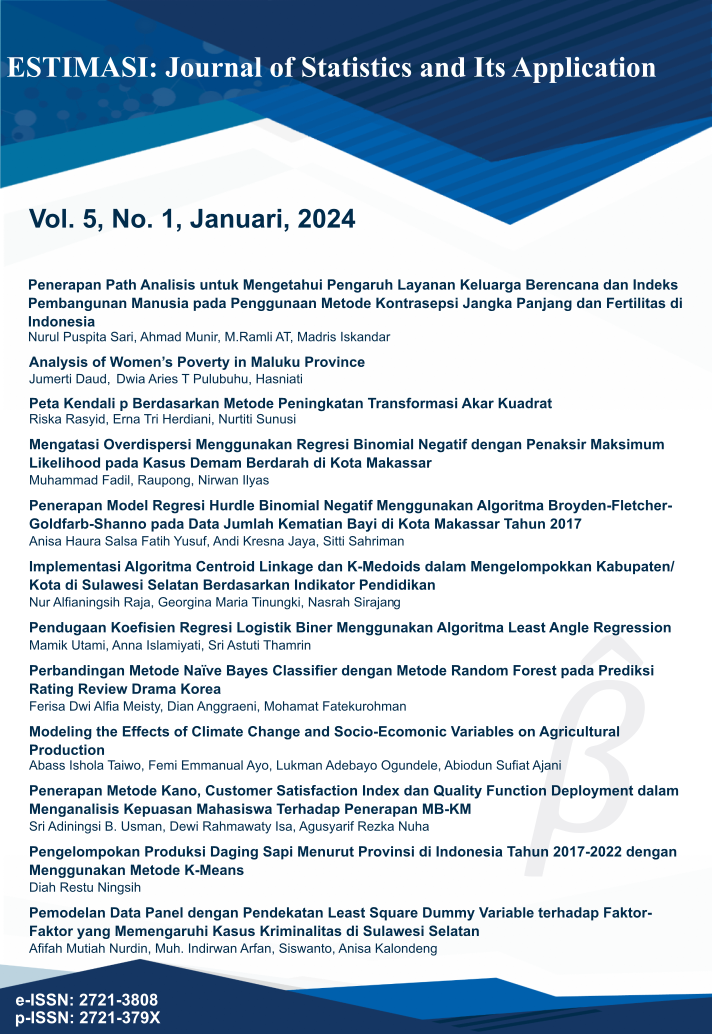Pengelompokan Produksi Daging Sapi Menurut Provinsi di Indonesia Tahun 2017-2022 dengan Menggunakan Metode K-Means
Keywords:
Beef, Production, Clustering, K-MeansAbstract
Demand for beef is a commodity that will continue to increase. In addition to nutritious milk and protein-rich meat, cows are very beneficial to humans. The consumption trend of Indonesians which continues to increase every year also shows this. However, adequate beef production, both in terms of quality and quantity, has not been sufficient to meet the increasing demand for beef. As a result, beef production has not been evenly distributed in all Indonesian provinces. This study aims to apply the K-Means Cluster method to group provinces and determine the characteristics of the clusters formed based on the level of beef production in Indonesia in 2017-2022. With this research, it can be input to the government and the people of Indonesia so that they can handle policies for regions that are included in the low cluster as an increase in the equity of beef production. This study clustered 3 groups. The results obtained were 10 provinces included in the low cluster, 21 provinces included in the medium cluster and 3 provinces included in the high cluster.
References
Revi, A., Solikhun, S., & Safii, M. Jaringan Syaraf Tiruan Dalam Memprediksi Jumlah Produksi Daging Sapi Berdasarkan Provinsi. Komik (Konferensi Nas. Teknol. Inf. Dan Komputer), 2(1), 297–304, 2018, Doi: 10.30865/Komik.V2i1.941.
Nugraha, T., Furqon, M. T., & Adikara, P. P. Peramalan Permintaan Daging Sapi Nasional Menggunakan Metode Multifactors High Order Fuzzy Time Series Model. J. Pengemb. Teknol. Inf. Dan Ilmu Komput. Univ. Brawijaya, 1(12), 1764–1770, 2017, [Daring]. Tersedia Pada: Https://J-Ptiik.Ub.Ac.Id/Index.Php/J-Ptiik/Article/View/640.
Rusdi M. D. Analisis Faktor-Faktor Yang Mempengaruhi Permintaan Daging Sapi Di Kota Surabaya. J. Ekonimi Bisnis, 1, 283–300, 2016.
Prakoso, L. D., Darmansah, D., Widia, T., & Hanifah, H. S. Implementasi Metode Moving Average Dalam Analisis Rantai Pasok Daging Sapi Di Indonesia. Jurikom (Jurnal Ris. Komputer), 9(3), 623, 2022, doi: 10.30865/Jurikom.V9i3.4223.
Devendra, C. Perspectives On Animal Production Systems In Asia. Livest. Sci., 106(1), 1–18, 2007, doi: 10.1016/J.Livsci.2006.05.005.
Kuntoro, B., Ari, R. R. A. M., & Nuraini, D. H. Mutu Fisik Dan Mikrobiologi Daging Sapi Asal Rumah Potong Hewan (Rph) Kota Pekanbaru. J. Peternak. 10(1), 1–8, 2013.
Lihayati, N., Pawening, R. E., & Furqan, M. Klasifikasi Jenis Daging Berdasarkan Tekstur Menggunakan Metode Gray Level Coocurent Matrix. Pros. Sentia, 8(1994), 305–310, 2016.
Emhar, A. Analisis Rantai Pasokan (Supply Chain) Daging Sapi Di Kabupaten Jember. 2014.
Gunawan, L. Analisa Perbandingan Kualitas Fisik Daging Sapi Impor Dan Daging Sapi Lokal. J. Hosp. Dan Manaj. Jasa, 1(1), Pp 1689-1699, 2013.
Nuhung, I. A. Performance, Constraint, And Strategy Of Achievement Of Meat Self-Sufficiency Program. Forum Penelit. Agro Ekon, 33(1), 63, 2015.
Ali, M. Prinsip Dasar Produksi Dalam Ekonomi Islam. Prinsip Dasar Produksi Dalam Ekon. Islam, 7(1), 19–35, 2013.
Pardanawati, S. L. Perilaku Produsen Islam. J. Ilm. Ekon. Islam, 1(1), 37–49, 2017, doi: 10.29040/Jiei.V1i01.6.
Asmara, M. A., & Ilmiyah, I. Fungsi Modal Sosial Dalam Meningkatkan Kesejahteraan Ekonomi: Studi Kasus Produksi Genteng Di Karang Penang Sampang. Al-Kharaj J. Ekon. Keuang. Bisnis Syariah, 4(2), 415–431, 2021, doi: 10.47467/Alkharaj.V4i2.681.
Ningsih, D. R., Intan, P. K., & Yuliati, D. Pemodelan Tindak Pidana Kriminalitas Di Kota Tangerang Menggunakan Metode Regresi Lasso. Estimasi J. Stat, 4(1), 64–77, 2023, doi: 10.20956/Ejsa.Vi.24853.
Agusta, Y. K-Means-Penerapan, Permasalahan Dan Metode Terkait. J. Sist. Dan Inform, 3, 47–60, 2007.
Talakua, M. W., Leleury, Z. A., & Taluta, A. W. Analisis Cluster Dengan Menggunakan Metode K-Means Untuk Pengelompokkan Kabupaten/Kota Di Provinsi Maluku Berdasarkan Indikator Indeks Pembangunan Manusia Tahun 2014. Barekeng J. Ilmu Mat. Dan Terap, 11(2), 119–128, 2017, doi: 10.30598/Barekengvol11iss2pp119-128.
Dhuhita, W. M. P. Clustering Menggunakan Metode K-Means Untuk. J. Inform., 15(2), 160-174, 2016.
Saragih, S. N., Safii, M., & Suhendro, D. Implementasi Metode K-Means Pada Hasil Produksi Daging Jenis Ternak. Jurasik (Jurnal Ris. Sist. Inf. dan Tek. Inform), 6(1), 235, 2021, doi: 10.30645/Jurasik.V6i1.288.
Sari, D. N. P., & Sukestiyarno, Y. L. Analisis Cluster Dengan Metode K-Means Pada Persebaran Kasus Covid-19 Berdasarkan Provinsi Di Indonesia. Prism. Pros. Semin. Nas. Mat, 4, 602–610, 2021, [Daring]. Tersedia Pada: Https://Journal.Unnes.Ac.Id/Sju/Index.Php/Prisma/.
Downloads
Published
Issue
Section
License
Copyright
It is the author's responsibility to ensure that his or her submitted work does not infringe any existing copyright. Authors should obtain permission to reproduce or adapt copyrighted material and provide evidence of approval upon submitting the final version of a manuscript.


